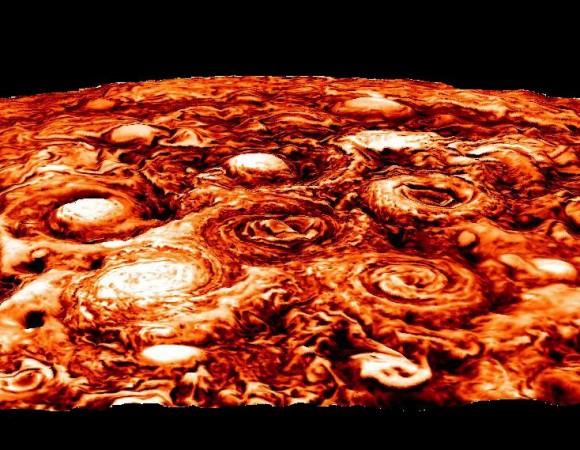
Jupiter's storms are larger, more ferocious, and stranger to anything else that has ever been observed in the Solar System so far. New research based on data from Nasa's Juno mission has made a few startling discoveries about the gas giant, including the fact that its storms extend for thousands of kilometers into the atmosphere.
Nasa's Juno Jupiter probe has completed ten of its science missions so far and the space agency has put out a few of its latest findings and images shot close to the planet's poles. According to Nasa, the winds in Jupiter not only run deep into the atmosphere, they also last longer than similar processes here on Earth.
Last month, Nasa revealed that the great red spot over Jupiter, its defining feature, will most likely be gone in about a decade. The spot, about 1.3 times the size of Earth, is a raging cyclone storm that has been brewing for hundreds of years.
The giant planet has other fierce storms as well, and recent studies have revealed quite a few things about them.
The width of the cyclones is astonishing, reports Nasa. They are about as wide as the distance between Naples and New York, noted lead author of the research Alberto Adriani, Juno co-investigator from the Institute for Space Astrophysics and Planetology, Rome.
"They have very violent winds, reaching, in some cases, speeds as great as 220 mph (350 kph). Finally, and perhaps most remarkably, they are very close together and enduring. There is nothing else like it that we know of in the solar system," he added.
As seen in the image, the storm over the North Pole looks like one large cyclone surrounded by eight smaller arms. The northern cyclones each range from between 4,000 and 4,600 km across in size. Jupiter's South Pole cyclone is a central storm with five circumpolar storms that are between 5,600 and 7,000 km across.

While these storms might look like the same cyclone with branched arms, they are actually separate storms that are densely packed. They are so tightly placed at the poles that their spiral arms actually touch each other. However, in spite of being so close, they have each managed to remain distinct. Each with their own individual morphologies, say the researchers.
"The question is, why do they not merge?" said Adriani. "We know with Cassini data that Saturn has a single cyclonic vortex at each pole. We are beginning to realize that not all gas giants are created equal."















